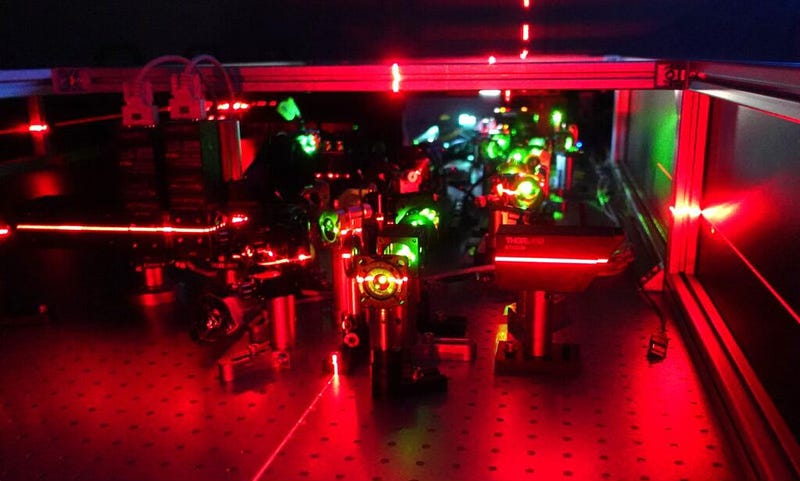This Laser That Could Unlock Fusion Energy, But Not In The Way You Think
Tokamak Energy's brilliant innovation.

I have said it a million times, but fusion power really could revolutionise the world. It could give us near limitless, affordable, on-tap energy, with only helium as a by product. But this utopian technology is currently far out of reach. Our reactors still use more energy to create fusion than they produce from fusion, which isn’t an ideal setup if you are trying to produce energy. However, UK-based Tokamak Energy is currently testing a laser that could unlock fusion power by solving one of the most significant flaws in our reactors.
As always, when discussing fusion, let’s quickly recap what fusion actually is. Fusion powers the Sun; the hydrogen plasma in its core is so hot and at such crushing pressure that the hydrogen atoms collide with enough kinetic force to overcome the repulsive force between them, fusing into a single larger helium atom. Due to some funky quantum physics, a single fusion event unleashes a tremendous amount of energy! So much so that the energy released from fusing 17 tonnes of hydrogen releases enough energy to power the entire US for a year!
We have developed several reactor designs that try to replicate this process on Earth through different “confinement” mechanisms. There is inertial confinement, such as the NIF reactor, which uses a laser to explode a pellet of hydrogen to create the temperature and pressure required to start fusion. There is also magnetic confinement, such as Tokamaks like JET and Tokamak Energy’s ST40, which uses superconducting magnets to compress and heat hydrogen plasma within a doughnut-shaped chamber to create fusion. However, it takes so much energy to power these lasers and magnets, and there is so much inefficiency within the hydrogen reactions that all of our reactors use significantly more energy than the fusion produces.
With this in mind, you might think that Tokamak Energy has, despite its name, developed a super-efficient laser. But you’d be wrong.
Their laser is actually a measurement tool for a tokamak reactor. It is planned to be fired across the reaction chamber of a tokamak. The laser and receiver are tuned to pick up utterly minuscule changes in the hydrogen. This will enable the scientists to get incredibly accurate real-time readings of the average density of the hydrogen fuel while the reactor is running.
Okay, so why is this so revolutionary? Well, one of the most significant inefficiencies of tokamaks is plasma instability, and this can solve that.
A tokamak has to keep the core of its hydrogen plasma fuel hot enough for fusion to occur, typically close to a million degrees Celsius, but also ensure the walls of the reactor don’t melt. This creates a massive temperature gradient around the fuel, which causes the edge of the plasma to be highly susceptible to instabilities. You can think of instabilities in the plasma like turbulence in a river. However, unlike a river, the plasma moves far faster and is exponentially more energetic. A river might turn into rapids when it experiences too much turbulence, slowing the flow and splashing its banks. When hydrogen plasma in a tokamak experiences instabilities, the amount of energy it ejects out of the plasma is colossal and is enough to damage the reactor’s walls. This, in turn, also means that energy is lost from the plasma, making the machine less efficient at initiating fusion.
All current tokamaks massively suffer from plasma instabilities. But we are now developing methods to combat this.
For example, I recently covered an AI that can predict the likelihood of plasma instability events 300 milliseconds in advance using current tokamak diagnostic data. The AI then dynamically manipulates the reactor’s electromagnetic field to keep the possibility of instability below a threshold. It has been tested and found to be highly effective. A few systems like this are currently being developed. However, ensuring that tokamaks can run without risk of instability and raising their efficiency to the point at which they can produce more energy from fusion than it takes to run them requires these systems to be far more effective than they currently are.
This is where Tokamak Energy’s new laser comes in. You see, they have already installed a Thomson scattering laser in their ST40 last year to provide detailed readings of plasma temperature and density at specific locations. This new laser will be installed later this year to supplement the Thomson scattering laser. Together, the two will provide scientists with real-time data on the state of the hydrogen plasma with a fidelity far higher than we have ever had before. This, in turn, will enable control systems, like the aforementioned AI, to operate far more effectively, as they have more, better data to work with.
While Tokamak Energy’s ST40 reactor is a record breaker, being the first privately owned fusion machine to achieve a plasma ion temperature of 100 million degrees Celsius, it is too small to achieve a net-gain in energy. So, we aren’t going to see Tokamak Energy passing that milestone next year once these lasers are fully installed. However, they can test and develop their plasma control systems that will use this laser. Why does that matter? Their upcoming STX and ST-E1 reactors, which are set to be up and running until the 2030s and will also use this laser technology, can in theory produce a net-gain in energy if they can keep their plasma under control. In other words, Tokamak Energy might be incredibly close to unlocking fusion power!
Thanks for reading! Content like this doesn’t happen without your support. So, if you want to see more like this, don’t forget to Subscribe and follow me on BlueSky or X and help get the word out by hitting the share button below.
Sources: Tokamak Energy, Interesting Engineering, WNN, Optics.org, Will Lockett, Energy.gov, Tokamak Energy

